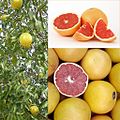Grapefruit
| Citrus × paradisi subsp. var. | Grapefruit | |||||||||||||||||||||||||||||||||||||||||||||||||||||||
|---|---|---|---|---|---|---|---|---|---|---|---|---|---|---|---|---|---|---|---|---|---|---|---|---|---|---|---|---|---|---|---|---|---|---|---|---|---|---|---|---|---|---|---|---|---|---|---|---|---|---|---|---|---|---|---|---|

|
|
| ||||||||||||||||||||||||||||||||||||||||||||||||||||||
| ||||||||||||||||||||||||||||||||||||||||||||||||||||||||
The grapefruit (Citrus × paradisi), is a subtropical citrus tree known for its bitter fruit, an 18th-century hybrid first bred in Barbados.[1]Template:Clarify When found it was named the "forbidden fruit";[2] it has also been misidentified with the pomelo or shaddock (C. maxima), one of the parents of this hybrid, the other being sweet orange (C. × sinensis).
These evergreen trees are usually found at around 5 – 6 m tall, although they can reach 13 – 15 m. The leaves are dark green, long (up to 150 mm, or 6 inches) and thin. It produces 5 cm in 0 white four-petaled flowers. The fruit is yellow-orange skinned and largely an oblate spheroid; it ranges in diameter from 10–15 cm. The flesh is segmented and acidic, varying in color depending on the cultivars, which include white, pink and red pulps of varying sweetness. The 1929 US Ruby Red (of the Redblush variety) has the first grapefruit patent.[3]
Cultivation
Propagation
Pests and diseases
Varieties
Grapefruit comes in many varieties, determinable by color, which is caused by the pigmentation of the fruit in respect of both its state of ripeness and genetic bent.[4] The most popular varieties cultivated today are red, white, and pink hues, referring to the internal pulp color of the fruit. The family of flavors range from highly acidic and somewhat bitter to sweet and tart.[4] Grapefruit mercaptan, a sulfur-containing terpene, is one of the substances which has a strong influence on the taste and odor of grapefruit, compared with other citrus fruits.[5]
Gallery
-
photo 1
-
photo 2
-
photo 3
References
- ↑ A~Z of Barbados Heritage, 2003, Macmillan Caribbean, ISBN 0333920686
- ↑ Fruits of warm climates
- ↑ Texas grapefruit history, TexaSweet. Retrieved 2 July 2008.
- ↑ 4.0 4.1 Cite error: Invalid
<ref>tag; no text was provided for refs namedWHF - ↑ Characterization of the Most Odor-Active Volatiles in Fresh, Hand-Squeezed Juice of Grapefruit (Citrus paradisi Macfayden), J. Agric. Food Chem., 1999, volume = 47, pages = 5189–5193
External links
- w:Grapefruit. Some of the material on this page may be from Wikipedia, under the Creative Commons license.
- Grapefruit QR Code (Size 50, 100, 200, 500)


